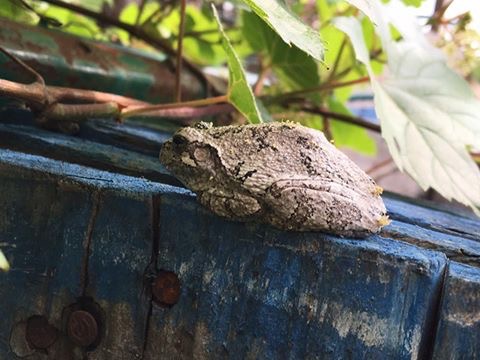The Detroit Zoological Society (DZS) has conducted programming with Oakland County Children’s Village for more than eight years, instilling reverence and respect for wildlife and wild places through gardening, education and conservation programs. Children’s Village provides a safe, structured environment for children and young adults that includes secure detention, residential treatment and shelter care services. Our collaboration initially began with a humane education-focused gardening program, which is still flourishing, but our programming has evolved over the years and we’ve had the opportunity to work with hundreds of young people there in various capacities.
One of our most recent endeavors was conducting FrogWatch USA training with some of the teen girls that we work with. FrogWatch USA is an amphibian conservation and citizen science collaborative effort among the Association of Zoos & Aquariums (AZA) and AZA-accredited zoos and aquariums throughout the U.S. Citizen science programs teach volunteers to collect data using the same protocol and methods, so all data can be counted as part of a scientific research project. One scientist working alone could never collect the amount of information a group of trained citizens can.
I recently went to Children’s Village along with Rebecca Johnson, the DZS’s associate curator of amphibians, to facilitate the FrogWatch USA training onsite. Rather than a traditional four-hour training, which takes place in one sitting, we divided up the training to take place over the course of two days in late March. The girls learned all about amphibians, how to identify frogs and toads by their breeding calls and what information we need to include on the data sheet when we go out and survey. We discussed how monitoring helps provide important information for each site, such as the diversity, population size and health of the particular frog or toad species that are present; whether or not there are rare or nonindigenous species in the area and what the overall health of the wetland is. Knowing which species are present at a site can even help improve the management and protection of a wetland and all species living there.
The girls have been working hard to learn the different frog and toad calls – they’ve been listening to a practice CD and identifying key characteristics that help to distinguish the different calls from one another. For example, a Western chorus frog call sounds like someone is running their fingernails along a fine-toothed comb and a wood frog sounds similar to the quacking of a duck.
Becky and I have accompanied the girls on their first outing to conduct surveys. This work must take place at least a half hour after sunset, so we went to our selected site at 8:30 p.m. There were 10 girls, three Children’s Village staff members and the two of us. When we arrived at our designated location, we remained still and quiet for two minutes per FrogWatch USA protocol, and then we listened and collected data for three minutes immediately following.
We heard a few different birds calling and something rustling in the reeds, which, much to our excitement, turned out to be a muskrat who eventually swam across the pond. A few of us even saw the space station travel overhead! But unfortunately, no frog or toad calls were heard. Fortunately, we’ve seen many American toads and even some tree frogs in the almost nine years that we’ve been facilitating the gardening program onsite, so we know we’ll hear calls soon. In the interim, it’s important for us to note on our data sheet that we didn’t hear anything, just as it will be important for us to document the calls that we will eventually hear.
To have a meaningful impact, we’ll need to collect data at least eight different times – no more than twice in one week – through August. Becky and I are planning to go out for another evening observation soon. After that, the girls and Children’s Village staff will continue on their own. I’m excited to see what unfolds this summer. It’s been an amazing experience for all involved thus far.
– Lisa Forzley is the curator of humane education for the Detroit Zoological Society and oversees the Berman Academy for Humane Education.



